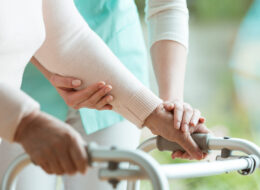Staying physically active becomes increasingly important for seniors as they age in order to better maintain optimal health and wellness.
Martial arts can be an excellent way for older adults to stay in shape, offering full-body workouts that can enhance strength, flexibility, balance, and coordination (skills that are essential for keeping elderly seniors mobile as they age).
Not all martial arts are equally suitable for seniors — intense martial arts such as Muay Thai may not be suitable due to their high impact levels and injury risk. However, more gentle martial arts like Tai Chi, which focus on breathing, balance, and slow, controlled movements, are ideal for older adults.
In this guide, we’ll highlight some of the best martial arts for seniors, helping older adults choose a martial arts practice that matches their needs and abilities.
With the right martial arts practice, seniors can reap the many physical and mental benefits of martial arts while having fun!
Forms of Martial Arts (And Which Are Best for Seniors)
There are many popular martial arts programs, but they all generally fall into specific categories which broadly align to a certain style. We’ll highlight the major martial arts training forms here (keep in mind that not all are suitable for seniors).
- Meditative Styles (Best for Seniors). Mediative types of martial arts are lower-impact and focus as much on breathing and mindfulness as fitness. These gentler martial arts practices are most recommended for seniors, offering numerous benefits such as improvements in balance and coordination. Examples of meditative martial arts include Tai Chi and Qi Gong.
- Weapon Styles (Can Be Appropriate for Seniors). Weapon styles are martial arts that involve the use of weapons such as bamboo sticks or swords. Weapon-based practices can be a good fit for some seniors since they are relatively low-impact. Keep in mind that holding a weapon may be exhausting for some — opt for lighter weapons when possible.
- Striking (Sometimes Appropriate for Younger Seniors). Striking martial arts use punches, kicks, knee strikes, and elbow strikes. Striking martial art styles come in a wide range — while many are safe for seniors with moderate fitness levels (and can easily be adapted for even easier levels), others may be too intense. Examples of striking styles include Karate, Kickboxing, Muay Thai, and Tae Kwon Do.
- Grappling (Not a Good Choice for Most Seniors). This style involves the use of holds, locks, and throws, with a focus on wrestling and low-to-the-ground movement. The vast majority of seniors will likely want to avoid grappling practices, as they can be quite violent, intense, and require a high level of physical fitness. Examples of grappling martial arts styles include Sambo and Brazilian Jiu-Jitsu.
- Throwing (Not a Good Choice for Most Seniors). Throwing practices use the opponents’ own bodyweight and momentum to throw them off balance and onto the ground. Throwing techniques are not usually recommended for seniors — usually only the youngins like the idea of being thrown to the floor. Examples of throwing or takedown martial arts styles include Aikido, Judo, and Wrestling.
Best Martial Arts for Seniors: Recommended Styles
We’ll review some of the best martial art programs for older adults, focusing first on more gentle practices before discussing martial art styles with more physical aspects and more rigorous movements involved.
Tai Chi (Meditative + Low Impact)
Tai Chi is a gentle martial arts style that originated in China and is often referred to as “moving meditation,” bringing together the min and the physical body.
The Tai Chi practice involves slow, flowing movements and deep breathing. It has a particular focus on relaxation, balance, and mindfulness.
Tai Chi is a great martial arts practice for seniors as it is low-impact, and the movements are adaptable to different fitness levels and abilities.
No wonder Tai Chi has always been popular with older Chinese practitioners — go out to any park in China and you’ll often see seniors practicing Tai Chi together with graceful, flowing movements.
Benefits for Seniors: The gentle art of Tai Chi can help improve flexibility, joint health, and balance, reducing the risk of falls. Not only that, it can also reduce stress and anxiety, improve sleep quality, and even boost overall mental well-being!
Qi Gong (Meditative + Low Impact)
Qi Gong is an ancient Chinese martial art practice that combines meditation, breathing exercises, and physical movements to promote balance and health.
Qi Gong is a low-impact practice that can be easily adapted to suit different fitness levels and abilities, making it an excellent choice for seniors.
With slow, fluid, and gentle movements, it’s perfect for those with limited mobility or joint issues.
Qi Gong’s philosophy emphasizes the connection between the mind and body while cultivating one’s internal energy or “Qi.” This philosophy can help seniors develop mental resilience and confidence.
Qi Gong classes also tend to have a less competitive focus, which may be more comfortable for older or more hesitant seniors.
Benefits for Seniors: Senior citizens practicing Qi Gong can receive many health benefits. Practitioners learn how to focus their breath and energy, promoting relaxation and stress reduction while also helping to improve balance, flexibility, and coordination.
Wing Chun (Striking + Fighting Style)
Wing Chun is a Chinese martial arts practice that emphasizes close-range combat and practical self-defense techniques by prioritizing simplicity, efficiency, and directness.
Wing Chun’s philosophy is based on the concept of using an opponent’s energy against them, rather than meeting force with force. This is done through the use of simultaneous attack and defense movements, allowing a practitioner to quickly neutralize an opponent’s attacks and strike back with minimal effort.
Wing Chun involves practicing simple, repetitive drills, allowing practitioners to perfect their techniques, and strengthen their reaction time, while toning their bodies.
Wing Chun is designed to be accessible to people of all sizes and fitness levels, making it an ideal practice for seniors who want to get some exercise while also learning basic self-defense skills.
Benefits for Seniors: Wing Chun is a martial art that can help improve coordination, balance, and strength. It also fosters mental alertness and awareness of one’s surroundings.
Kendo (Weapon-Based)
Kendo is a Japanese martial art that involves the use of bamboo swords, or “shinai,” and protective armor to simulate combat.
Since it’s a weapon-based practice, Kendo is considered low-impact, making it an ideal martial art for seniors. There are plenty of Kendo practitioners well into their 70s!
Kendo focuses on correct posture, footwork, and swordsmanship, with practitioners learning how to strike, block, and parry using a shinai, while also developing their physical abilities and coordination.
Kendo’s philosophy emphasizes mental discipline, focus, and respect.
Benefits for Seniors: Kendo can help improve a senior’s mobility, coordination, and balance through its focus on footwork, potentially reducing the risk of falls.
Kali (Weapon-Based)
Kali is an ancient Filipino martial art that focuses on weapon-based combat, with practitioners using sticks and knives to practice their striking and defensive techniques.
Kali utilizes a wide variety of strikes, blocks, and parry movements — making it well-suited for self-defense for seniors who could use a boost of confidence.
Although Kali does involve weapon use, it is considered low-impact, making it a great choice for seniors who want to ease the impact on their joints.
Kali also emphasizes developing speed and reaction time in order to help practitioners respond quickly and instinctively in combat.
Benefits for Seniors: Kali can help improve a senior’s hand-eye coordination, reflexes, and reaction time, aiding in overall physical fitness, coordination, and balance for reducing the risk of falls and injuries.
Martial Arts Practices for More Mobile Seniors
Most elderly seniors will likely want a less strenuous martial art practice. But, for younger seniors who are up for something with more rigorous movement and sweat involved, the martial art practices below may be appropriate.
Karate (Striking + Fighting, Moderate Energy)
Karate is a traditional Japanese martial art that focuses on striking techniques, such as punches and kicks, to defend oneself against an opponent.
Karate is a very well-known and popular martial art practice. As a result, there are often many types of karate classes structured to accommodate different fitness levels and abilities. This makes it more likely that a senior can find a class that is well-suited for them where they can learn safely and at their own pace.
Karate is a practice with a philosophy focused on discipline and perseverance, ideal for boosting self-confidence while building strength and agility.
Benefits for Seniors: Karate can help improve seniors’ cardiovascular health, muscle strength, coordination, and agility, while also helping seniors build confidence and social connections.
Taekwondo (Striking + Fighting, Moderate Energy)
Taekwondo is a Korean martial art based on kicking and punching movements.
While it can be a great workout and provide practical self-defense skills, Taekwondo may not be the best choice for seniors due to its high-impact nature.
However, Taekwondo can be adapted to different fitness levels and, with proper modifications it may be accessible to seniors who are in good physical health and looking for a challenging workout involving punching techniques.
Seniors interested in Taekwondo should consult with their physician and an experienced instructor to determine if it is an appropriate choice for them.
Benefits for Seniors: Taekwondo can help seniors achieve better cardiovascular health, work on core muscles, balance, and overall fitness.
Martial Arts Practices for Seniors to Avoid
We do not generally recommend these martial art programs for older adults. While these programs have many benefits, they are also very physically demanding and have a higher risk of injury than other martial art practices detailed above.
- Aikido. Aikido is a Japanese martial art that emphasizes using an attacker’s force and momentum against them, rather than brute strength. While its philosophy of non-aggression can be very beneficial, it focuses on throws and pinning techniques that are likely too difficult or dangerous for older practitioners due to the high risk of injury.
- Judo. Judo involves a lot of throwing techniques, grappling, and ground fighting, which can be dangerous for elderly seniors who are at a higher risk for serious injuries and have more fragile bones.
- Krav Maga. Krav Maga involves a lot of aggressive, physical contact. For many seniors, the intensity and risks associated with Krav Maga are likely too much to handle.
- Brazilian Jiu-Jitsu. Brazilian Jiu-Jitsu involves a lot of submission holds and ground grappling, which can be dangerous and cause serious injury to seniors.
- Kickboxing. This martial art is high-intensity and requires a significant level of physical activity, making it unsuitable for many older seniors.
- Kung Fu. Kung Fu incorporates a range of complex striking movements and stances and is generally too demanding for elderly seniors.
Elements to Consider When Choosing a Martial Arts Program for Seniors
- Impact Level. High-impact martial arts such as boxing or karate can be too jarring for seniors’ joints and may be more likely to result in injury. Opt for lower-impact classes that avoid shoving or throwing.
- Class Experience Level. Another important consideration for seniors when choosing a martial art is the class experience or class level. Seniors may feel more comfortable and motivated in classes specifically designed for older participants or beginners. Some martial arts classes may cater more to higher levels of experience, which may not be suitable for seniors who are just starting or have limited mobility.
- Sparring. Seniors looking to start a martial arts practice should consider avoiding classes that emphasize sparring or dueling. Sparring involves simulated fighting between students and can be physically demanding and risky, particularly for older individuals. With reduced reflexes, slower reaction times, and decreased bone density, seniors are put at an increased risk of injury during sparring. While sparring can be an exciting aspect of martial arts for younger individuals, seniors should avoid sparring for safety’s sake.
- Accessibility. Older seniors will want to choose martial arts classes that are easily accessible and convenient — such as classes located close to one’s home or with ample parking and wheelchair accessibility.
- Flexibility requirements. Elderly seniors will want to choose martial arts that focus on gentle movements and exercises to improve flexibility and range of motion. Avoid classes that require a significant amount of flexibility from the outset.
- Martial Arts School. The type of martial arts school you attend can have a huge impact on one’s martial arts training and experience. A martial arts class run through a senior center will be catered to older adults (even when the martial art style is traditionally more intense). If you’re unsure, always call ahead to a training school and talk to the instructors about what type of class would best fit your needs.
Benefits of Practicing Martial Arts for Seniors
Martial arts offers a variety of health benefits for seniors. Some of the most common benefits include:
- Flexibility. Starting martial arts can help seniors maintain or improve flexibility and range of motion, which is key to avoiding injury and maintaining independence.
- Strength. Strength training combined with martial arts exercises can help seniors build muscle strength resulting in better overall health and mobility.
- Mental Focus. Martial arts practices that are focused on meditation and mindfulness can help seniors reduce stress and anxiety levels.
- Balance. Many martial arts programs involve balance exercises, which can improve coordination and reduce a senior’s fall risk.
- Socialization. Joining a martial arts class can also provide seniors with an opportunity to socialize and prevent loneliness.
Martial Arts Alternatives for Seniors
Practicing martial arts isn’t for everyone. There are plenty of martial arts alternatives for those looking for a more gentle workout, and who aren’t interested in Tai Chi or Qi Gong.
- Dance: Dancing is a fun and low-impact activity that can help improve balance, coordination, and cardiovascular health. There are many dance styles to choose from, such as ballroom, swing, or line dancing, and many classes cater specifically to seniors.
- Swimming: Swimming is another popular low-impact exercise for older adults — plus, it’s a nice way to cool off during hot weather!
- Pilates: Pilates focuses on building core strength, flexibility, and balance. It can help improve posture and greatly improve overall health. Just make sure to find a class that’s senior-specific, as pilates classes can range quite a bit in terms of how strenuous they get.
- Yoga: Yoga is a wonderful senior-friendly exercise practice that combines physical postures, breath control, and meditation. Yoga can also be adapted to suit different fitness levels and abilities, and there are often many senior-friendly classes available at senior centers or local yoga studios.
There are a variety of options for older adults looking to learn martial arts, with more physically-demanding practices like karate as well as more gentle forms like tai chi.
Many martial arts practices provide numerous physical benefits as well as mental benefits, including stress relief, community building, and self-defense skills. Learning martial arts can also be a huge confidence booster!
The best martial arts for older adults is any program the adult feels safe and comfortable performing. Always consult with a medical professional before embarking in a new rigorous martial arts training program, to be safe.
FAQ About Best Martial Arts for Seniors
What martial arts program is best for older adults?
The best martial arts program for older adults are often more gentle practices that are lower-impact.
Tai Chi is an especially popular martial art practice for older adults, with an emphasis on relaxation, balance, and mindfulness. It’s a low-impact practice that can improve joint health and flexibility.
Qi Gong is another popular and gentle martial art practice for seniors, combining gentle movements, breathing techniques, and meditation.
Is 60 too old to start martial arts?
No, there are plenty of seniors who practice martial arts well into their 70s and even older. However, we’d recommend opting for more gentle and slow-moving martial arts practices like Tai Chi or Qi Gong. Avoid high-impact martial arts programs with an increased risk of injury, such as Krav Maga, Judo, or Brazilian Jiu-Jitsu.
Is Krav Maga good for older adults?
No, we would not recommend Krav Maga for older adults. Krav Maga involves a lot of harsh physical contact, with heavy punches and throws. If you really want to consider it, make sure to consult with your doctor first.




